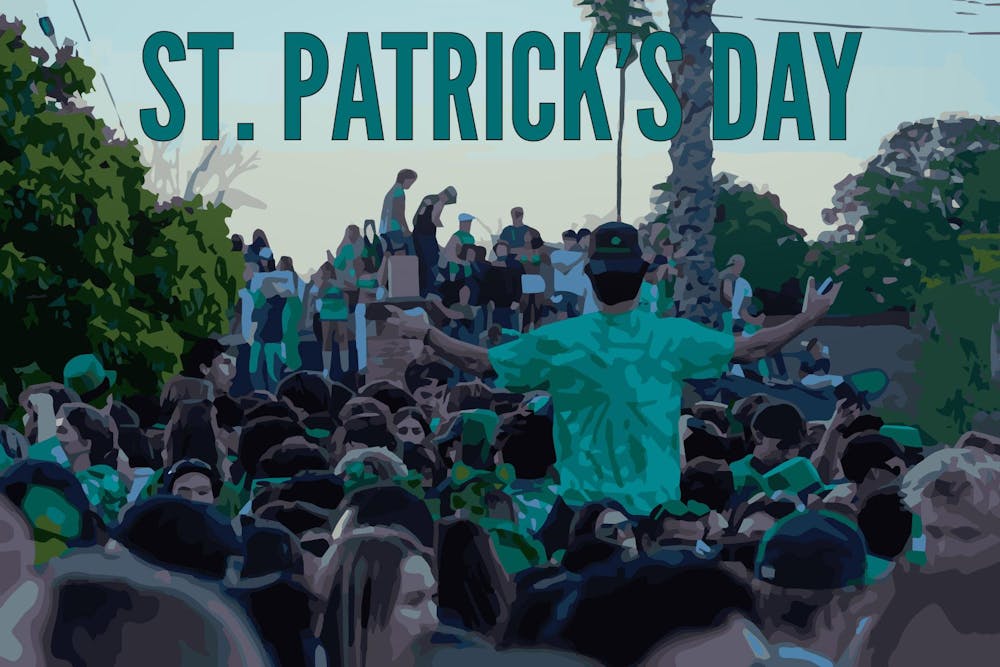At the University of Notre Dame, the very home of the Fighting Irish, St. Patrick’s Day feels like a major holiday … or at least, it should. We aren’t on campus for it — and that’s probably by design.
@cruznah Replying to @Tik Toker was an intereting day chat #stfrattys #calpolyslo #calpolyfratty ♬ Yummy - ?
Last Saturday, California Polytechnic Institute in San Luis Obispo celebrated “St. Fratty’s Day” — an annual block party to celebrate St. Patrick’s Day. The event is very similar to Notre Dame’s annual “darty” in Legacy Village around spring break, which features a “Running of the Gingers.”
But Cal Poly is infamous for its wild St. Patrick’s Day celebrations. In 2015, a roof collapsed during the block party, injuring eight. But college students come and go, and they unfortunately tend to keep making the same mistakes. After St. Fratty’s Day 2024, Cal Poly and its surrounding areas were completely trashed.
According to local news, as many as 6,000-7,000 people showed up as early as 3:30 a.m. to prepare for the party. Students who lived on the street where the party took place could not leave their homes. Several dorms were damaged and the dining halls were ransacked.
In an email to the campus community, Cal Poly president Jeffrey Armstrong said one of the dorms had “damage so extensive that university officials were forced to temporarily close the building and evacuate about 300 student residents to repair and restore fire suppression and alarm systems, clean up destruction and debris from smashed ceiling tiles and marred floors, and provide deep cleaning and air quality restoration throughout.”
Armstrong acknowledged there were more visitors to campus this year than usual, according to local news. A Cal Poly freshman Victor Nicolacakis posited the damage was done by outsiders. “It was people coming in doing stupid stuff and getting out of there with no consequences and just leaving us to pick up the pieces,” he said in an interview with KSBY.
Several hundred miles across the country, the city of Chicago was experiencing the same thing: outsiders coming in, trashing the place and leaving — and I was one of them. (Although, I didn’t steal or damage property.)

Saturday morning, as the city dyed the Chicago River green, hordes of people from the surrounding Chicagoland area took the Metra and the CTA into the city with green “borgs” in hand. Bridges over the river were jam-packed with people, relegating regular sidewalk traffic to a stand-still. Lines for pubs and restaurants were out the door and around the block. Empty bottles littered sidewalks and streets. The parade was impossible to see past a sea of people’s shoulders.
Public bathrooms were hard to find or purposefully shut down for the weekend, and when you could finally spot one, it was chaos. For women, it was at least a 15-minute wait for a room of crowded stalls and people puking in sinks. And often, there was no toilet paper.
In a moment of clarity in the middle of William P. Fahey Bridge, surrounded by sweaty and drunk strangers, I suddenly regretted not dragging my friends to Chicago Gaelic Park in the suburbs — an Irish cultural center my grandma has loved to frequent since its foundation in 1983. Gaelic Park was a large part of my childhood in Chicago, and the key reason why I wanted to go is because the people there were invested in the longevity of the cultural center, unlike the tourists in Chicago.
Defeated, with our hands cold, our clothes green and our constitutions weakened, we departed early on the incredibly crowded 3+ hour train ride back to South Bend. And hey, at least we got to share a green beer in the train station bar.

But is this what St. Patrick’s Day is really about?
As Ireland becomes a more popular tourist destination, and as pop culture increasingly venerates (or, arguably, fetishizes) Irish men, this St. Patrick’s Day felt more energetic than most. But I wonder if us Americans — like the outsiders at Cal Poly and at Chicago’s Riverfront — will abandon Irish culture after the holiday (or this current Irish fad) is over.
Whatever the answer is, I really don’t know, but I certainly won’t be celebrating St. Patrick’s Day in Chicago again anytime soon. Instead, I think of my grandmother, who grew up near the Irish coast in County Mayo. She loves dancing and having a little bit of whiskey with her coffee, but most importantly, she loves Ireland. She’s never abandoned her roots, and the celebration of Irish culture is an everyday practice for her.
She leaves you all a message: “Happy, happy St. Patrick’s Day to everyone! Go out, enjoy and make happy memories. Love you, Nana.”











